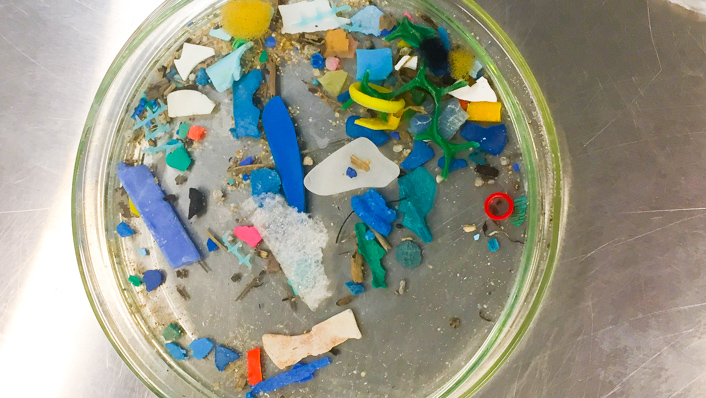We live in a world where plastic is everywhere, its cost effectiveness has made it a preferred choice to create most things. In recent years awareness of the impact of plastic has grown. As plastic continues to degrade in our land and oceans, we need to educate ourselves on the harm that microplastics can bring. Microplastics detox is an idea that aims to reduce the exposure of microplastics to our bodies to live happier and healthier lives.
Here’s a fun fact, did you know the average American eats a credit card worth of plastic every week?
Read on to understand;
- What exactly microplastics are
- Why microplastics are harmful
- How we can perform a microplastics detox to reduce our exposure to toxins associated with microplastics.
What are microplastics?
Microplastics are very small pieces of plastic that measure less than five millimetres in diameter. There are two types of microplastics, primary and secondary.
Primary microplastics are items that have been intentionally created in a small size for commercial use such as microbeads found in cosmetic products, or microfibers from clothing. Secondary microplastics are a result of the degradation and breakdown of bigger plastic objects, for example, water bottles. Degradation of these larger plastic items is caused by environmental factors such as wind abrasion, radiation from the sun, and wave impacts.
Why are microplastics harmful?
Microplastics do not easily break down, they can last thousands of years before they fully decompose. During this time, these persistent materials spread their toxicity across the environment.
These microplastics are problematic in more ways than one. They are extremely difficult to remove from our environment due to their size and the fact they are found pretty much everywhere. The obvious one being the ocean. But microplastics have also been found in mountains, our drinking water, and the air.
Microplastics are regarded as a global issue due to the negative impact they can have on the health of organisms that come in contact with them. A study that looked into the toxic effects of microplastic on fish and humans, found microplastics collect in the gastrointestinal system of fish. These plastics then spread to other body tissues causing various health problems, such as energy depletion and reproductive organ damage. Microplastics pose a big threat to the biodiversity and balance of the ecosystem within the ocean.
Fish being a staple in the human diet means that these nasty microplastics are passed on up the food chain. It’s been common knowledge that certain plastics can have negative health effects but, the same study linked neurotoxicity, chronic inflammation, oxidative stress, and DNA damage from microplastics, which can potentially cause cancer.
Taking the above into account, it’s vital to try to reduce the intake of microplastics. This can be achieved by being more conscious of what we eat and drink and how we interact with plastics.

Microplastics detox
Microplastics have infested our body, existing in our blood, brain, and lungs. To help reduce our exposure to microplastics and decrease the negative health impacts, we should look to make certain lifestyle and dietary changes.
Avoid plastic where possible
This is an obvious one but there are certain considerations and behaviours that some people may not be aware of.
eating out of plastic takeaway tubs
Plastic containers mixed with heat will release harmful microplastics and chemicals, this is especially true for styrofoam.
Opt for safer alternative containers such as glass.
SINGLE-USE PLASTIC
Avoid plastic packaging and opt for reusable bags where possible. It can be hard to find products that aren’t packaged in plastic but they are slowly becoming more common, a food market can also be a good place to purchase food produce without plastic packaging.
Avoid reusing water bottles and instead, opt for a glass water bottle instead.
CLOTHING
Look for natural material clothing such as cotton, instead of synthetic materials such as polyester and nylon which will shed microplastics from abrasion and the washing machine.
Diet
Deciding what we eat and drink is instrumental to our health, our well-balanced healthy diet gives us the ability to grow and repair and promotes a healthy life.
FILTERED WATER
Normal tap water can contain a greater number of microplastics and harmful chemicals such as chlorine.
Drinking filtered water can remove most if not all of these unwanted pollutants, a simple carbon filter should do but some people use a water distiller or reverse osmosis machine which can be more effective.
FRUITS & VEGETABLES
Cruciferous vegetables such as cauliflower and broccoli help detoxify our bodies.
SEAFOOD
Fish in the ocean are regularly ingesting microplastic so by limiting the ingestion of seafood we’re reducing our exposure to microplastics. If you are eating seafood, try to avoid bottom feeders such as catfish and prawns.
CANNED FOODS
Canned foods have a high amount of microplastics, especially canned tuna. There should be glass jar alternatives that will reduce the ingestion of microplastics.
BPA DAMAGE
BPA is known to interfere with the endocrine system which regulates the reproductive system and other important biological processes, and has its exposure has been linked to cancer.
There is a study to support that certain foods and natural ingredients can reduce damage induced by BPA exposure;
- Sweet potato
- Green tea
- Kefir
- Fenugreek
- Pumpkin seed oil
- Ginseng



Leave a Reply